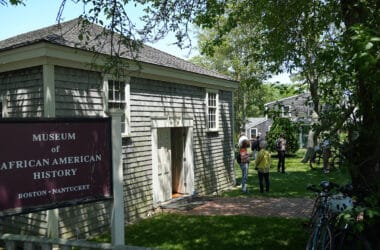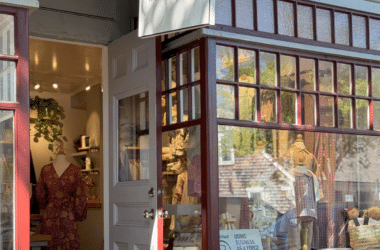As part of the Nantucket Historical Association’s 2025 featured exhibition, Behind the Seams: Clothing and Textiles on Nantucket, they have invited Nantucket community members to contribute a panel to a conceptual quilt. A celebratory display of the works of art will be revealed at the NHA’s Community Day, planned for […]
Nantucket History & People
It’s a Family Tradition
“It’s in his blood.”
“He comes by it naturally.”
How many times do we hear someone say things like this? I’m guessing that these are common refrains if you’re hanging out around the University of Texas football field, watching young Arch Manning warming up. Arch, projected to be one of college football’s better quarterbacks this season, is the son of Cooper Manning. Cooper was a football player at one time as well, destined to play for Ole Miss, but a diagnosis of spinal stenosis caused Cooper to leave the game. Cooper went on to have a successful career as an entrepreneur, a slight variation of the quarterback business.
Honoring Juneteenth
This Thursday, June 19 a collaboration of Nantucket organizations are hosting an island gathering to memorialize and honor Juneteenth. The block party at the African Meeting House, 29 York Street, runs from 11 am to 3 pm and will include music, a documentary screening, games, arts & crafts, food, and […]
A Voice Alive on the Page
In contemporary American literature, Dawn Tripp stands out as an author who bridges the worlds of poetry, essay, and historical fiction with a strong voice and impressive literary finesse. A nationally bestselling author whose novel The Season of Open Water won the Massachusetts Book Award for Fiction, Tripp is a writer with an extraordinary ability to paint with her words a compelling picture of complex historical figures and intimate human experiences. Tripp’s literary craftsmanship and storytelling skills overlay deep and careful research of her subjects—her newest novel, Jackie, took her ten years to research and write.
Uniting Community with New Exhibit & Project
On May 23, the Nantucket Historical Association launches its 2025 main exhibition, Behind the Seams: Clothing and Textiles on Nantucket, in the Nantucket Whaling Museum. Showcasing over 150 remarkable pieces from the NHA’s costume and textile collections, this exhibit brings to life the craft, culture, and identity woven into Nantucket’s […]
What Goes Around Comes Around
At a time when sustainability is more than just a buzzword, there’s a shop on Nantucket leading the charge in redefining how we think about fashion. This innovative clothing store at 18 Federal Street called assemble isn’t just selling apparel: it’s championing a revolutionary approach to minimize waste and maximize resource efficiency through a robust circular economy model. With its B Corp certification and a diverse roster of 40 global brands and small makers, assemble is setting a new standard for what it means to be both stylish and environmentally conscious.
The Nantucket Skiff that Came Full Circle
Boating is in the hearts and souls of many Nantucketers. For centuries here, traveling the seas was a way of life as well as a livelihood. Island lore has many stories of the exploits of sailors and the fates of the vessels they sailed. Only a few are as heartwarming as the journey of a skiff built by an island father with his son, that has returned decades later to the family of the man who crafted it .
The story begins a little more than forty years ago, when skilled builder, woodworker, and fourth-generation Nantucketer Bruce Killen and his young son David embarked on a project to build a skiff. A gifted craftsman known for his historic restoration, fine custom work, and attention to detail, Killen built boats in his spare time. According to his widow, Pamela, “Bruce built a lot of skiffs: it was a hobby. He’d build them and then give them away or sell them… I remember him in his shop, with blues music going, dancing around and building his boats,” she reminisced. “He really enjoyed building them.”
“This was the second of three flat-bottom skiffs that were designed and built by Bruce,” his son David added. “This skiff was built in Bruce’s shop on Cliff Road, back when there was a raised rear portion partitioned by an oiled tarp. In watching the design and construction of any of Bruce’s boatwork back then, the term ‘part art, part science’ comes to mind.”
Skiffs are simple and reliable: small open boats with usually just an outboard
engine and seats, with room for two or three. They’re good for teaching boating skills, and it was in Bruce’s skiffs that he taught his sons boating. “I learned drive outboard with a tiller extension in these boats. I also improved my rowing and problem-solving skills when the outboard failed. Adventuring on small boats, having things go wrong, and having to figure out how to problem-solve to get home is a pretty good foundational skill set for anyone,” said David.
“Growing up in the 70’s and 80’s on Nantucket was a gift. The maritime history of our community was all around us—from the shipwrecks on the north side of Coatue that became visible after a winter Nor’Easter, to the active fishing and merchant marine community, to the owners of wooden sailboats whose preservation led to events like the Opera House Cup. I’ve been a lifelong member of the maritime and sailing community both on Nantucket and in the larger world. My son Owen is 8 years old, and I’ve been ‘showing him the ropes’ as well.”
For a few years, the skiff served the father and son duo faithfully. It was even used a few winters to hold the Christmas tree floating off Easy Street in the Killen family’s beloved tradition that was started by Bruce Killen’s father, Sidney. “Bruce and David would go out, chop down a tree and put it in the boat,” Pam recounted. Bruce decorated it, and Ginger Andrews used to supply the electricity.”
As time passed, however, the skiff’s journey took a new turn.
In 1982, Nantucket artist G.S. Hill and his wife Judi bought a 12-foot skiff that they used to travel around island waters and to get from their home to their gallery, which was then on Old South Wharf. “We bought it from Byron Coffin: it had been the tender to the Sally Bramble… but it needed help. For three years in a row, I would give it to Bruce Killen to repair over the winter,” Greg Hill explained. “After three years, Bruce said ‘this cannot be fixed any more: would you like to buy my boat’?”
And so Greg and Judi did.
“The craftsmanship was beautiful—we used to get a lot of compliments on the boat—Bruce used Nantucket colors: red bottom, clear wood, and gray.”
During the years that the G.S. Hill Gallery was on Old South Wharf, the Hill’s had a mooring between the cottages. “I’d putter around the harbor in it and paint and sketch…I used to do a lot of painting from it.” Greg became a common sight around Nantucket, locals recognizing the skiff and the artist driving it. “One day,” Judi Hill added, “Tom Dickson stopped by and said ‘Hey Judi, I just saw Greg in his office.’” The name stuck, and from that day onward, “Greg’s Office” is what they called the skiff.
For years the skiff was a part of Hill’s creative process. G.S. Hill is known for his evocative artwork that captures the essence of island life, and if you look closely, Greg’s Office appears in a number of his paintings and sketches.
When the G.S. Hill Gallery moved to Straight Wharf, the Hills could no longer moor it by the gallery, so they moored the boat in Polpis Harbor. “From Polpis Harbor, I’d drive it over to Straight Wharf to pick Judi up from work,” Greg commented. The couple used the skiff on their rare days off to travel to little-known, serene beaches, where they could unwind, picnic, and savor the quiet beauty of Nantucket. “We used to take it out to Polpis Harbor where it is real narrow—even on the busiest days, we’d be the only ones there, and we could watch the sailboats,” Judi added.
But time has a way of bringing change, and recently Hill decided it was time to part with Greg’s Office. The decision was bittersweet: “we’d had so much fun with it for so many years, but sometimes it’s just time…”
Judi took to social media to list the boat for sale, sharing a photo and a heartfelt ad. In a cinematic twist, a response came through almost immediately: This is Pam Killen, and I want to buy the boat. “I swear, it took less than a minute to sell it,” Judi commented.
Pamela and her son David had not realized Greg and Judi Hill had this skiff that Bruce Killen had built. “I’m pleased that they did [have the skiff]—they did an amazing job preserving it,” David said. Both Pam and David are excited that the skiff has returned to the family. Pam plans to enjoy the skiff with her three grandchildren: ages 4, 7, and 8. “I’m going to teach my son and nephews how to drive an outboard with a tiller extension,” David added.
Today, the skiff is back with the family who built it, a full circle of memories, craftsmanship, and shared history. It stands as a tribute to the bond between a father and son, the inspiration of an artist, and the enduring value of craftsmanship. “I’ve always associated wooden boatbuilding with the highest form of woodwork and artistry,” commented David Killen. “The interconnection between wooden boatbuilding on Nantucket and the local community of visual artists created a warm and beautiful sense of place and community. I hope we can all take a minute to remember where we came from and be grateful for the experience.”
In the end, this handcrafted skiff is more than just a vessel. It’s a piece of history, a link between generations, and a symbol of how things made with love can find their way back to where they belong.
A Sea Monster Visits
Nantucket’s famous sea monster visits our island again this week when the Nantucket Historical Association celebrates its “Summer of Sarg” on Monday, August 5 with a free Community Day from 10 am to 3 pm. The re-creation of Tony Sarg’s 75-foot sea monster balloon will be on display for all […]










